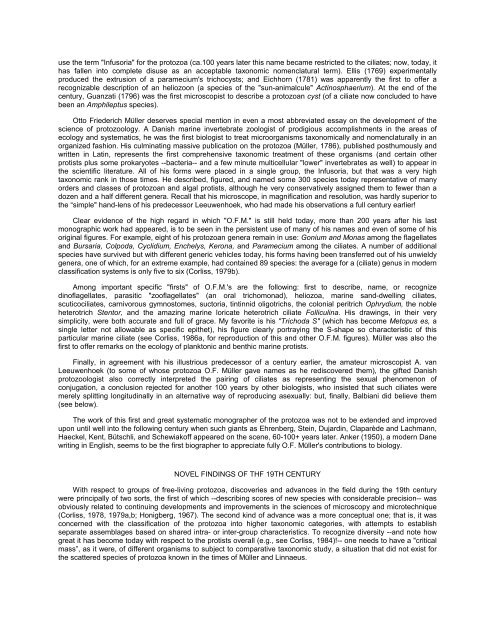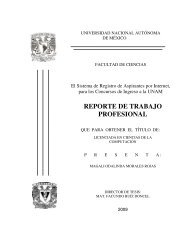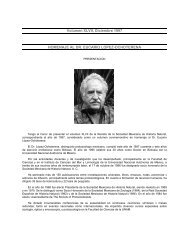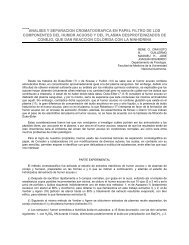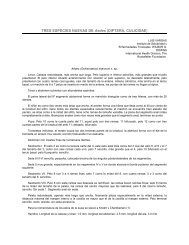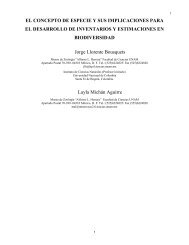aqueous habitats (see the <strong>de</strong>tailed accounts in Dobell, 1932, and in Schierbeek, 1960).Leeuwenhoek's first drawings of protozoa appeared in the year 1638; they were of the opalinid Cepe<strong>de</strong>a and theciliate Nyctotheroi<strong>de</strong>s, both taken from the gut of a frog. Over the years (he lived a long and fruitful life),Leeuwenhoek also probably saw and/or <strong>de</strong>scribed species of other microorganisms today c<strong>la</strong>ssified in the protozoangenera Anthophysa, Bodo, Carchesium, Cercomonas, Chilodonel<strong>la</strong>, Chilomastix, Ch<strong>la</strong>mydomonas, Coleps,Colpidium, Cothurnia, Crithidia, Cyclidium, Dileptus, Eimeria, Elphidium, Euplotes, Giardia, Haemotococcus, Kerona,Monas, Opalina, Oxytricha, Paramecium, Polytoma, Stylonychia, Tetrahymena, Trichodina, Trichomonas, Volvox,and Vorticel<strong>la</strong> (see Corliss, 1975).Leeuwenhoek's discoveries were all the more amazing consi<strong>de</strong>ring the simplicity of his "microscopes” with theirsingle lens, no draw-tube, no mirror, etc., although these small hand-lenses possessed a magnification up to nearly300X. It should also be noted that his observations were not confined to morphological <strong>de</strong>scriptions alone. Heconsi<strong>de</strong>red the pairing of ciliates to be conjugal in nature; he <strong>de</strong>scribed reproduction in Volvox in some <strong>de</strong>tail; and hecommented on the contractility of (the stalk of) Vorticel<strong>la</strong>. (Note: Leeuwenhoek's dates of birth and <strong>de</strong>ath are notgiven in this paper, nor are those of the many other "philosophers in little things” mentioned on the following pages,to be consistent. This information (along with photographs) is supplied in Corliss (1978, 1979a) for some 70distinguished microscopists/protozoologists all of whom are inclu<strong>de</strong>d among the top lea<strong>de</strong>rs <strong>de</strong>scribed in the presentpaper, so it has seemed unnecessary to further lengthen my accounts here by repeating data below. Photographs ofstill additional persons, but limited to ciliatologists, appear in Corliss (1979b).)There were a few other notable protozoological pioneers of the <strong>la</strong>te 17th century. For example, in 1678,Christiaan Huygens <strong>de</strong>scribed several ciliates and Astasia, but in a private letter to his ol<strong>de</strong>r brother, material notpublished until 1899 (see the story in Dobell, 1932, p. 164). Buonanni (1691) was the first to publish a drawing of aciliate (probably a species of Colpidium); King (1693) portrayed various free-living protozoa, including a form we nowrecognize as Euplotes; and Harris (1696) rediscovered Leeuwenhoek's Euglena.THE 18TH CENTURYThroughout the 18th century, with one major exception (O.F. Müller: see below) only scattered <strong>de</strong>scriptivemicrobiologists/microscopists left accounts that inclu<strong>de</strong>d information on any protozoa. These "firsts" should berecor<strong>de</strong>d here. Recall, however, that the second half of the 1700's was dominated in biological fields by therenowned systematist Linnaeus, the Father of Mo<strong>de</strong>rn Taxonomy and Nomenc<strong>la</strong>ture. Unfortunately, Linnaeus,primarily a botanist, paid little attention to the "lowest animals" (the term "Protozoa" was not coined until the early19th century: see below). In the well-known 10th edition of his Systema Naturae (Linnaeus, 1758: starting date forzoological nomenc<strong>la</strong>ture), only the generic name Volvox appeared. In the 12th edition (Linnaeus, 1767), Chaos,Furia (a name long since dropped), and Vorticel<strong>la</strong> were ad<strong>de</strong>d; several other names avai<strong>la</strong>ble in the literature (e.g.,Hill's ciliates of the year 1752: Cyclidium, Enchelys, and Paramecium) were totally neglected. With respect to algalprotists, recall that in Linnaeus (1753), the work that represents the starting date for (most) botanical nomenc<strong>la</strong>ture,some 14 genera of algae were listed (recall that he consi<strong>de</strong>red Volvox as a "zoophyte), although only four (Chara,Conferva, Fucus, and Ulva) have been accepted as true algae as the group has been re<strong>de</strong>fined since Linnaeus'time.The iso<strong>la</strong>ted studies mentioned above inclu<strong>de</strong> Joblot's (1718) small but pioneering treatise on microscopes andthe tiny organisms ma<strong>de</strong> visible through their proper usage. The enterprising Frenchman gave various protozoavernacu<strong>la</strong>r names: for example, his "chausson" has endured as today's "slipper-animalcule", an apt <strong>de</strong>scription ofParamecium. And he was the first to <strong>de</strong>scribe a contractile vacuole. Trembley's (1744) remarkable observations ondivision in Stentor and certain other ciliates also <strong>de</strong>serve to be remembered, as Tartar (1961) has rightly stressed.Hill (1752) was the earliest nomenc<strong>la</strong>tural taxonomist of single-celled organisms; as mentioned above, hecoined generic names for a number of protozoa. While it is true that such names cannot legally be credited to him--since by the International Co<strong>de</strong> of Zoological Nomenc<strong>la</strong>ture the starting date for "animals" is 1758, as has beenpointed out above-- they could have been used by Linnaeus in his c<strong>la</strong>ssification of all organisms, and subsequentworkers would, quite properly, have credited the Swedish naturalist with them. In his book, the Englishman Hill alsoinclu<strong>de</strong>d historically valuable notes on microtechniques of the time.Baker (1753) offered good <strong>de</strong>scriptions of the <strong>la</strong>rge and most unusual luminescent marine dinof<strong>la</strong>gel<strong>la</strong>te <strong>la</strong>ternamed Noctiluca and of the graceful "swan" ciliate Lacrymaria. Rösel von Rosenhof (1755) studied a <strong>la</strong>rgefreshwater amoeba, which Linnaeus (1767) put in the genus Chaos. Wrisberg (1765) is said to have been the first to
use the term "Infusoria" for the protozoa (ca.100 years <strong>la</strong>ter this name became restricted to the ciliates; now, today, ithas fallen into complete disuse as an acceptable taxonomic nomenc<strong>la</strong>tural term). Ellis (1769) experimentallyproduced the extrusion of a paramecium's trichocysts; and Eichhorn (1781) was apparently the first to offer arecognizable <strong>de</strong>scription of an heliozoon (a species of the "sun-animalcule" Actinosphaerium). At the end of thecentury, Guanzati (1796) was the first microscopist to <strong>de</strong>scribe a protozoan cyst (of a ciliate now conclu<strong>de</strong>d to havebeen an Amphileptus species).Otto Frie<strong>de</strong>rich Müller <strong>de</strong>serves special mention in even a most abbreviated essay on the <strong>de</strong>velopment of thescience of protozoology. A Danish marine invertebrate zoologist of prodigious accomplishments in the areas ofecology and systematics, he was the first biologist to treat microorganisms taxonomically and nomenc<strong>la</strong>turally in anorganized fashion. His culminating massive publication on the protozoa (Müller, 1786), published posthumously andwritten in Latin, represents the first comprehensive taxonomic treatment of these organisms (and certain otherprotists plus some prokaryotes --bacteria-- and a few minute multicellu<strong>la</strong>r "lower" invertebrates as well) to appear inthe scientific literature. All of his forms were p<strong>la</strong>ced in a single group, the Infusoria, but that was a very hightaxonomic rank in those times. He <strong>de</strong>scribed, figured, and named some 300 species today representative of manyor<strong>de</strong>rs and c<strong>la</strong>sses of protozoan and algal protists, although he very conservatively assigned them to fewer than adozen and a half different genera. Recall that his microscope, in magnification and resolution, was hardly superior tothe “simple" hand-lens of his pre<strong>de</strong>cessor Leeuwenhoek, who had ma<strong>de</strong> his observations a full century earlier!Clear evi<strong>de</strong>nce of the high regard in which "O.F.M." is still held today, more than 200 years after his <strong>la</strong>stmonographic work had appeared, is to be seen in the persistent use of many of his names and even of some of hisoriginal figures. For example, eight of his protozoan genera remain in use: Gonium and Monas among the f<strong>la</strong>gel<strong>la</strong>tesand Bursaria, Colpoda, Cyclidium, Enchelys, Kerona, and Paramecium among the ciliates. A number of additionalspecies have survived but with different generic vehicles today, his forms having been transferred out of his unwieldygenera, one of which, for an extreme example, had contained 89 species: the average for a (ciliate) genus in mo<strong>de</strong>rnc<strong>la</strong>ssification systems is only five to six (Corliss, 1979b).Among important specific "firsts" of O.F.M.'s are the following: first to <strong>de</strong>scribe, name, or recognizedinof<strong>la</strong>gel<strong>la</strong>tes, parasitic "zoof<strong>la</strong>gel<strong>la</strong>tes" (an oral trichomonad), heliozoa, marine sand-dwelling ciliates,scuticociliates, carnivorous gymnostomes, suctoria, tintinnid oligotrichs, the colonial peritrich Ophrydium, the nobleheterotrich Stentor, and the amazing marine loricate heterotrich ciliate Folliculina. His drawings, in their verysimplicity, were both accurate and full of grace. My favorite is his "Trichoda S" (which has become Metopus es, asingle letter not allowable as specific epithet), his figure clearly portraying the S-shape so characteristic of thisparticu<strong>la</strong>r marine ciliate (see Corliss, 1986a, for reproduction of this and other O.F.M. figures). Müller was also thefirst to offer remarks on the ecology of p<strong>la</strong>nktonic and benthic marine protists.Finally, in agreement with his illustrious pre<strong>de</strong>cessor of a century earlier, the amateur microscopist A. vanLeeuwenhoek (to some of whose protozoa O.F. Müller gave names as he rediscovered them), the gifted Danishprotozoologist also correctly interpreted the pairing of ciliates as representing the sexual phenomenon ofconjugation, a conclusion rejected for another 100 years by other biologists, who insisted that such ciliates weremerely splitting longitudinally in an alternative way of reproducing asexually: but, finally, Balbiani did believe them(see below).The work of this first and great systematic monographer of the protozoa was not to be exten<strong>de</strong>d and improvedupon until well into the following century when such giants as Ehrenberg, Stein, Dujardin, C<strong>la</strong>parè<strong>de</strong> and Lachmann,Haeckel, Kent, Bütschli, and Schewiakoff appeared on the scene, 60-100+ years <strong>la</strong>ter. Anker (1950), a mo<strong>de</strong>rn Danewriting in English, seems to be the first biographer to appreciate fully O.F. Müller's contributions to biology.NOVEL FINDINGS OF THF 19TH CENTURYWith respect to groups of free-living protozoa, discoveries and advances in the field during the 19th centurywere principally of two sorts, the first of which --<strong>de</strong>scribing scores of new species with consi<strong>de</strong>rable precision-- wasobviously re<strong>la</strong>ted to continuing <strong>de</strong>velopments and improvements in the sciences of microscopy and microtechnique(Corliss, 1978, 1979a,b; Honigberg, 1967). The second kind of advance was a more conceptual one; that is, it wasconcerned with the c<strong>la</strong>ssification of the protozoa into higher taxonomic categories, with attempts to establishseparate assemb<strong>la</strong>ges based on shared intra- or inter-group characteristics. To recognize diversity --and note howgreat it has become today with respect to the protists overall (e.g., see Corliss, 1984)!-- one needs to have a "criticalmass”, as it were, of different organisms to subject to comparative taxonomic study, a situation that did not exist forthe scattered species of protozoa known in the times of Müller and Linnaeus.
- Page 1 and 2: HISTORICALLY IMPORTANT EVENTS, DISC
- Page 6 and 7: With regard to various parasitic (b
- Page 8 and 9: Acephalina (for one subgroup of the
- Page 10 and 11: (Elphidium: see above) and by vario
- Page 12 and 13: Vernworn (1889), setting the stage
- Page 14 and 15: esearch, see Foissner, 1987). Sever
- Page 16 and 17: were located at Columbia University
- Page 18 and 19: protozoological research. Pitelka's
- Page 20 and 21: BÜTSCHLI, O., 1876. Studien Über
- Page 22 and 23: CLEVELAND, L.R., 1956. Brief accoun
- Page 24 and 25: DOBELL, C., 1928-1943. Researches o
- Page 26 and 27: Protistenk., 77: 152-174.GELEI, J.
- Page 28 and 29: HERTWIG, R. und E. LESSER, 1874. Ue
- Page 30 and 31: (year 1949): 57-79.KIRBY, H., 1950b
- Page 32 and 33: LEVINE, N.D., 1988. The Protozoan P
- Page 34 and 35: OLIVE, L.S., 1975. The Mycetozoans.
- Page 36 and 37: PUYTORAC, P. de, J. GRAIN, and J.-P
- Page 38 and 39: SONNEBORN, T.M., 1970. Methods in P
- Page 40: WICHTERMAN, R., 1953. The biology o


